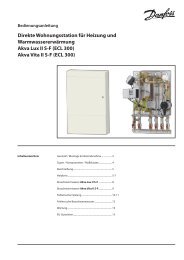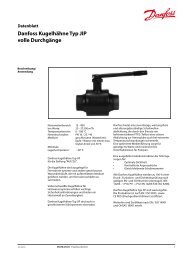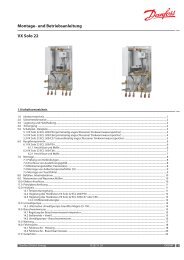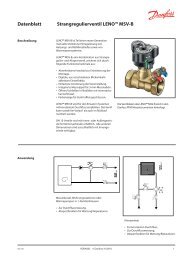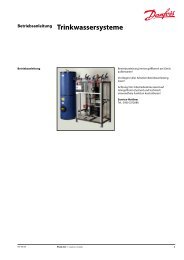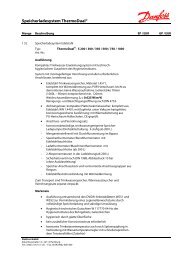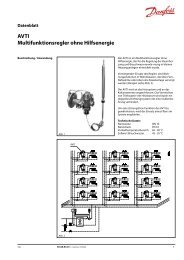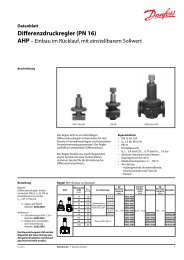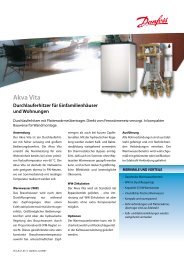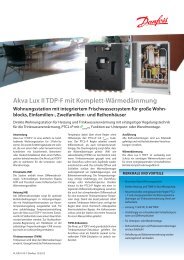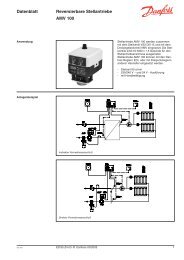MBA Fernwärmestationen [VIEHJ103]_Sept09.pdf
MBA Fernwärmestationen [VIEHJ103]_Sept09.pdf
MBA Fernwärmestationen [VIEHJ103]_Sept09.pdf
Sie wollen auch ein ePaper? Erhöhen Sie die Reichweite Ihrer Titel.
YUMPU macht aus Druck-PDFs automatisch weboptimierte ePaper, die Google liebt.
1530BetriebsanleitungFernwärmeübergabestationen3. Montage Mounting Montage3.4 Wandmontage( 1 ) Bohrschablone42,4Einfachthermostat( 2 ) BohrschabloneDoppelthermostat( 3 ) Biegeradius ≥ 5 mm.3.5 Rohrmontage( 1 ) Länge nachBedarf kürzen.( 4 ) Fühler mit Formfeder gegenHerausgleiten sichern.Wall mounting( 1 ) Drilling jig,single thermostat( 2 ) Drilling jig,dual thermostat( 3 ) Bending radius ≥ 5 mm.( 4 ) Shaped spring securesprobe against sliding outMontage mural( 1 ) Gabarit de perçagethermostat simple( 2 ) Gabarit de perçagethermostat double( 3 ) Rayon de courbure ≥ 5 mm.( 4 ) Sonde avec ressort desécurité pour assurer lemaintien dans la gaine.9595( 1 )Ø 4,595,4( 2 )Ø 4,5Pipe mounting( 1 ) Shorten accordingto requirements.Montagetuyaterie( 1 ) Raccourcir longueursuivant besoin.4. Einstellungen / Funktionen Settings / functions Réglages / Fonctions4.1 Sollwerteinstellung TRSetpoint adjustment TRRéglage de consigne TRBegrenzung RegelbereichControl range limitingLimitation de la plage de réglage4.3 Entriegeln STB / STB reset / Déverrouillage STB4.2 Sollwert- / GrenzwerteinstellungTW/STW/STBSetpoint / limit settingTW/STW/STBRéglage seuil/consigneTW/STW/STB( 3 )( 4 )Nach Unterschreiten deseingestelllten Grenzwertesum ca. 10% kann derSTB entriegelt werden.The STB can be resetwhen the temperature hasfallen about 10% belowthe preset limit.Si la température descendsous le seuil limite d'env.10 %, le STB peut êtredéverrouilléØ 40 - 120 mm( 1 )T max = 120°C4.4 Verhalten bei Bruch des MesssystemsBei Zerstörung des Messsystems, d.h. wenn die Ausdehnungsflüssigkeitentweicht, fällt der Druck in der Membraneab und öffnet beim STW und STB bleibend den Stromkreis.Beim STB ist ein Entriegeln nicht mehr möglich.Response to measuring system fractureIf the measuring system is destroyed (i.e. the expansionliquid leaks) then the membrane pressure falls andthe circuit will be permanently opened in the case of anSTW or STB. On an STB, resetting is no longer possible.Comportement en cas de rupture dusystème de mesureEn cas de destruction du système de mesure, c.-à-d.lorsque le liquide d’expansion s’échappe, la pressiondans la membrane chute et le circuit électrique resteouvert pour STW et STB . Un déverrouillage n’est pluspossible pour STB .4.5 Verhalten bei UntertemperaturWird der Fühler beim STW oder STB auf eineTemperatur unter ca. -20°C abgekühlt öffnetsich der Stromkreis, schließt sich jedoch beiTemperaturanstieg wieder selbsttätig.Response to low temperatureIf the probe temperature on an STB or STWfalls below about -20°C, the circuit will open,but will automatically close again when thetemperature rises.Comportement si la températureest trop basseLorsque la temperature passe sous -20°Cpour STW ou STB, le circuit électriques’ouvre, mais se referme automatiquementlorsque la température remonte.4.6 Schutzart IP 54Zum Erreichen der Schutzart IP 54müssen die Dichtungselemente wiedargestellt eingelegt sein.IP54 protectionTo achieve the enclosure protectionrating IP54, the sealing elementsmust be inserted as shown in thediagram.Schutzart IP 54Pour atteindre l’indice de protectionIP 54 les joints doivent être positionnéscomme ci-dessous représentés.4.7 Plombierung(Plombe nicht im Lieferumfang)Lead sealing(not included in delivery)Plomb(Plombs non fournis)(1) Bohrung beidseitig nur im schraffierten Bereich(1) Driill only in the cross-hatched area on both sides(1) Perçage latéral uniquement dans la zone hachurée5. Installation Electrical connection Raccordement électrique5.1 Vorschriften und Hinweise■ Der elektrische Anschluss darf nur von Fachpersonal durchgeführt werden.■ Bei der Wahl des Leitungsmaterials, bei der Installation und beim elektrischenAnschluss des Gerätes sind die Vorschriften der VDE 0100 "Bestimmungen überdas Errichten von Starkstromanlagen mit Nennspannungen unter 1000 V" bzw.die jeweiligen Landesvorschriften zu beachten.■ Das Gerät völlig vom Netz trennen, wenn bei Arbeiten spannungsführende Teileberührt werden können.Regulations and notes■ The electrical connection must only be made by qualified personnel.■ The choice of cable, the installation and the electrical connection must conform to therequirements of VDE 0100 “Regulations for the installation of power circuits with nominalvoltages below 1000 V”, or to the appropriate local regulations.■ If contact with live parts is possible while working on the unit, it must be completely disconnectedfrom the supply.■ Earth the instrument at the PE terminal to the protective conductor. This cable must have aPrescriptions et remarques■ Le raccordement électrique doit être effectué exclusivement par du personnel qualifié.■ Aussi bien pour le choix du matériau des câbles, que pour l’installation ou bien le raccordementélectrique de l’appareil, il faut respecter la réglementation en vigueur.■ Débrancher les deux conducteurs du réseau lorsque des pièces sous tension peuventêtre touchées lors d’une intervention sur l’appareil.■ Raccorder l’appareil à la terre sur la borne PE, avec le conducteur de protection. Ceconducteur doit avoir la même section que les lignes d’alimentation.■ Gerät an der Klemme PE mit dem Schutzleiter erden. Diese Leitung sollte mindestensden gleichen Querschnitt wie die Versorgungsleitungen aufweisen.cross-section that is at least as large as the supply cables.5.2 Elektrischer AnschlussRaccordement électrique■ -Kontakt (Steckklemme) * geeignet für Anschlussquerschnitt0,75...2,5mm 2 feindrähtig, feindrähtig mit Aderendhülse eindrahtig.■ Anschlussverbindung geeignet für fest verlegte Leitungen. Leitungseinführungmit Zugentlastung. Anbringungsart X bzw. M.■ Anschluss gemäß Anschlussbild durchführen.TR, TW, STW: STB: ■ Leitungen vorbereiten /Prepare the cables / Préparation des câbles11Electrical connection■ contact (plug-in terminal) * suitable for conductor cross-section 0.75 — 2.5 mm 2 .Use core-end ferrule with stranded conductor.■ Connection suitable for fixed cabling. Cable entry with strain relief.Attachment type X or M.■ Implement the connection according to the wiring diagram.■ Anschluss herstellen / Make the connection / BrancherØ 6-12mmTR:STB:■ Contact (borne à fiche) * adapté à une section de fil 0,75 à 2,5mm 2 de faiblediamètre, faible diamètre avec embout unifilaire.■ Raccordement adapté à des câbles fixes. Entrée de câble avec décharge de traction.Type de fixation X ou M.■ Raccordement suivant schéma de raccordement■ Anschluss lösen / Disconnection / Débrancher816( 1 )2 42 42 4 111-13mm( 1 )( 2 ) SW 24 / 24 a/f / OC24( 2 )( 1 ) geeignetes Crimpwerkzeug verwenden( 1 ) Use a suitable crimpng toolmax. 3 mm( 1 ) Utiliser l’outil de sertissage adapté*„Push-In ® “-Klemmtechnik: patentierte Anschlusstechnik der Weidmüller GmbH & Co. KG, Detmold *“Push-In ® “ terminal technology is patented by Weidmüller GmbH & Co. KG, Detmold *Technologie „Push-In®“ : connexion à insertion brevetée par Weidmüller GmbH & Co. KG, Detmold6. Technische Daten Technical data Caractéristiques techniqueszulässige UmgebungstemperaturimGebrauchzulässigeLagertemperaturmaximaleSchaltleistungminimaleSchaltleistungerforderlicheAbsicherungSchaltpunktgenauigkeitmittlererUmgebungstemperatureinflussbezogen aufden SollwertAn Fernleitungund Schaltkopfmax. +50°Cmax. +50°C, min. -30°CAm Öffnungskontakt(Kontaktbahn 1-2)Am Schließkontakt(Kontaktbahn 1-4)TR, TW, STW:STB:Am Temperaturfühlermax. Sollwert +15%AC 230 V +10%, 16 (2,5) A,cos ϕ = 1 (0,6)DC 230 V +10%, 0,25 AAC 230 V +10%, 6,3 (2,5) A,AC 230 V +10%, 2 (0,4) A,cos ϕ = 1(0,6)DC 230 V +10%, 0,25 AZur Gewährleistung einer möglichst großen Schaltsicherheitwird eine Mindestbelastung von:AC / DC = 24 V, 100 mA empfohlenPermissible ambienttemperaturein operationPermissiblestorage temperatureMax.contact ratingMin.contact ratingat capillary and switch head+50°C max.maximum +50°C, minimum -30°Cfor break contact (SPST-NC)(contacts 1-2)for make contact (SPST-NO)(contacts 1-4)TR, TW, STW:STB:at temperature probemax. setpoint: +15%230 V AC +10%, 16 (2.5) A,p.f. = 1 (0.6)230 V DC +10%, 0.25 A230 V AC +10%, 6.3 (2.5) A,230 V AC +10%, 2 (0.4) A,p.f. = 1(0.6)230 V DC +10%, 0.25 AIn order to ensure the maximum switching reliability, we recommend aminimum contact loading of:AC / DC = 24 V, 100 mATempérature ambianteadmissible en serviceTempérature de stockageadmissiblePouvoir de coupuremax.Pouvoir de coupuremin.Sur le capillaire et le boîtiermax. +50°Cmax. +50°C, min. -30°CSur le contact à ouverture(contacts principaux 1-2)Sur le contact à fermeture(contacts principaux 1-4)TR, TW, STW:STB:Sur la sonde detempératureConsigne max. +15%AC 230 V +10%, 16 (2,5) A,cos ϕ = 1 (0,6)DC 230 V +10%, 0,25 AAC 230 V +10%, 6,3 (2,5) A,AC 230 V +10%, 2 (0,4) A,cos ϕ = 1(0,6)DC 230 V +10%, 0,25 APour garantir la plus grande sécurité de coupure possible, nousvous recommandons une charge minimale de :AC / DC = 24 V, 100 mABemessungsstoßspannung: 2500 V rated surge voltage: 2500 V Surtension transitoire de référence : 2500 Vsiehe max. SchaltleistungRequiredsee max. contact rating Fusible nécessaire Voir pouvoir de coupure maximalfusingbezogen auf den Sollwert bei T U +22°C = siehe Typenschildangabenam Gerät.Bei einer Abweichung der Umgebungstemperatur am Schaltkopfund der Fernleitung von der Justierumgebungstemperatur+22°C, entsteht eine Schaltpunktverschiebung.Höhere Umgebungstemperatur = niedriger Schaltpunkt;Niedrigere Umgebungstemperatur = höherer Schaltpunkt.Je nach Geräteausführung wird dieser Einfluss durch Einsatzeiner Temperaturkompensation minimiert.Switching pointaccuracyMean ambienttemperature effect,referred to setpointreferred to the setpoint at T A +22°Csee nameplate data on the instrumentA deviation of the ambient temperature around the switching head orthe capillary from the calibration temperature of +22°C wil cause a shiftof the switching point.Higher ambient temperature = lower switching pointLower ambient temperature = higher switching pointThis effect can be minimized by using a temperature compensation,depending on the instrument configuration.Précision du point decontactInfluence moyenne dela températureambiantePar rapport à la consigne pour T U +22°C = voir indication de laplaque signalétiqueEn cas de dérive de la température ambiante sur le boîtier et le capillaire+22°C, il en résulte un déplacement du point de contact.Température ambiante plus élevée = point de contact plus bas ;Température ambiante plus basse = point de contact plus haut.Suivant l’exécution, cette influence est minimisée au moyen d’unecompensation de température.Gewicht ca. 0,2 kg Weight approx. 0.2 kg Poids env. 0,2 kgSchutzart EN 60 529 - IP 40 (IP 54). Verschmutzungsgrad 2 Enclosure protection EN 60 529 - IP40 (IP54). Pollution level 2 Mode de protection EN 60 529 - IP 40 (IP 54). Degré de pollution 2Betriebsmedium Wasser, Öl, Luft, Heissdampf Operating medium water, oil, air, superheated steam Milieu d’utilisation eau, huile, air, vapeurZeitkonstante t 0,632in Wasser ≤ 45 sTime constant t 0.632in water ≤ 45 secConstantes de tempsdans l’eau ≤ 45 sin Öl ≤ 60 sin Luft / Heissdampf ≤ 120 sin oil ≤ 60 secin air/superhtd. steam ≤ 120 sect 0,632dans l’huile ≤ 60 sdans l’air / vapeur ≤ 120 sWirkungsweise gemäß DIN EN 60 730-1, DIN EN 60 730-2-9 und DIN EN 14597 Mode of operation as per EN 60 730-1, EN 60 730-2-9 and EN 14597Fonctionnement suivant EN 60 730-1, EN 60 730-2-9 et EN 14597TR, TW : Typ 2BLTR, TW : Type 2BLTR, TW : type 2BLSTW : Typ 2BKLNPSTW : Type 2BKLNPSTW : type 2BKLNPSTB : Typ 2BFHKLNPVSTB : Type 2BFHKLNPVSTB : type 2BFHKLNPV108VI.EH.J1.03.108 © Danfoss 09/2009DH-SM/DE


![MBA Fernwärmestationen [VIEHJ103]_Sept09.pdf](https://img.yumpu.com/41101449/108/500x640/mba-fernwarmestationen-viehj103-sept09pdf.jpg)

